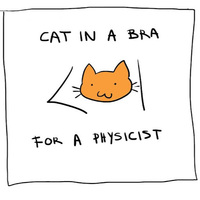Hugo Hao
Syracuse University, Department of Physics, Graduate Student
We present the design of a reflective stop-band filter based on quasi-lumped elements that can be utilized to introduce large dc and low-frequency voltage biases into a low-loss superconducting coplanar waveguide (CPW) cavity.... more
We present the design of a reflective stop-band filter based on quasi-lumped elements that can be utilized to introduce large dc and low-frequency voltage biases into a low-loss superconducting coplanar waveguide (CPW) cavity. Transmission measurements of the filter are seen to be in good agreement with simulations and demonstrate insertion losses greater than 20 dB in the range of 3 to 10 GHz. Moreover, transmission measurements of the CPW's fundamental mode demonstrate that loaded quality factors exceeding 10 5 can be achieved with this design for dc voltages as large as 20 V and for the cavity operated in the single-photon regime. This makes the design suitable for use in a number of applications including qubit-coupled mechanical systems and circuit QED. The integration of bias circuitry into high-quality (low-loss) microwave cavities for controlling embedded components is an important technical issue for a range of topics that includes research with qubit-and cavity-coupled mechanical systems,[1-10] circuit QED,[11, 12] and quantum dynamics of nonlinear systems.[13, 14] In these scenarios , the applied potentials and currents serve a variety of functions such as maintaining a device's operating state or establishing tunable electrostatic interactions between devices. However, if not carefully engineered, the introduction of the requisite circuitry can degrade the quality of a cavity through increased external circuit loading and radiative losses,[15] which generally have a detrimental effect on the given application. In recent years, several solutions to this problem have been developed for dc biasing of superconducting copla-nar waveguide (CPW) cavities. These cavities play an important role in the applications mentioned above due to their large electric field density[16, 17] and high intrinsic quality factors (10 6).[18] The solutions put forth for biasing such cavities utilize either half-wavelength or quarter-wavelength traces for band-stop filtering or high-impedance isolation of the bias circuitry's connections to the cavities.[19, 20] This has enabled operation of biased CPWs with loaded quality factors in the range of 10 3-10 4 for several applications.[12, 14, 19, 21] However, the reliance on wavelength-specific isolation geometries results in a narrow band of controlled isolation around a specific operating frequency, which could be problematic in instances where multiple devices with different or tun-able energy scales are integrated into the cavity and thus require broadband isolation. Important examples of this include proposed techniques for the dispersive read-out of a qubit-coupled nanoresonator embedded inside a CPW cavity.[2, 3] For such techniques to be feasible, the qubit and CPW, which can be detuned in energy by several GHz, should have linewidths comparable to or smaller than the nanoresonator-qubit coupling strength, which is controlled by a large dc voltage (∼ 10 s V); this requires both the CPW and qubit to be well-isolated at their respective energies from the bias circuitry. FIG. 1. a) Schematic of a CPW cavity and the reflective T-filter used for applying dc potentials to the CPW's center trace. Ports 1 and 2 are the traditional input and output ports of the CPW cavity. Port 3 is the filtered dc port. b) Optical image of one T-filtered CPW resonator studied here. The device is representative of all the samples studied in this work with a 5.3 GHz fundamental CPW mode and symmetric coupling capacitors, C in and Cout (inset, lower left), each composed of a single set of overlapping fingers. The inset in the upper-right displays a close-up of the filter's interdigitated capacitor and one meander line inductor. The inset in the lower-right displays the connection between the filter and the CPW. Here we report a design that overcomes the challenge of obtaining broadband isolation in low frequency lines of a CPW cavity by utilizing a superconducting reflective T-filter.[21] This design provides high cavity isolation covering most of the frequency range typically used by elements in planar circuit QED architectures. Moreover , it allows for application of dc voltages as high as 20 arXiv:1409.7727v1 [cond-mat.mes-hall]
Superconducting metamaterials are a promising resource for quantum information science. In the context of circuit QED, they provide a means to engineer on-chip, novel dispersion relations and a band structure that could ultimately be... more
Superconducting metamaterials are a promising resource for quantum information science. In the context of circuit QED, they provide a means to engineer on-chip, novel dispersion relations and a band structure that could ultimately be utilized for generating complex entangled states of quantum circuitry, for quantum reservoir engineering, and as an element for quantum simulation architectures. Here we report on the development and measurement at millikelvin temperatures of a particular type of circuit metamaterial resonator composed of planar superconducting lumped-element reactances in the form of a discrete left-handed transmission line (LHTL) that is compatible with circuit QED architectures. We discuss the details of the design, fabrication, and circuit properties of this system. As well, we provide an extensive characterization of the dense mode spectrum in these metamaterial resonators, which we conducted using both microwave transmission measurements and laser scanning microscopy (LSM). Results are observed to be in good quantitative agreement with numerical simulations and also an analytical model based upon current-voltage relationships for a discrete transmission line. In particular, we demonstrate that the metamaterial mode frequencies, spatial profiles of current and charge densities, and damping due to external loading can be readily modeled and understood, making this system a promising tool for future use in quantum circuit applications and for studies of complex quantum systems.
